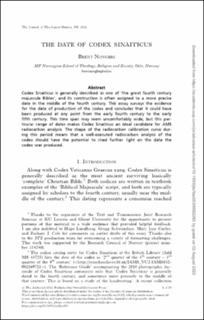| dc.contributor.author | Nongbri, Brent | |
| dc.date.accessioned | 2023-02-08T11:50:36Z | |
| dc.date.available | 2023-02-08T11:50:36Z | |
| dc.date.created | 2022-11-01T12:30:26Z | |
| dc.date.issued | 2022 | |
| dc.identifier.citation | Journal of Theological Studies. 2022, 73 (2), pages 516-534 | en_US |
| dc.identifier.issn | 0022-5185 | |
| dc.identifier.uri | https://hdl.handle.net/11250/3049249 | |
| dc.description.abstract | Codex Sinaiticus is generally described as one of ‘the great fourth century majuscule Bibles’, and its construction is often assigned to a more precise date in the middle of the fourth century. This essay surveys the evidence for the date of production of the codex and concludes that it could have been produced at any point from the early fourth century to the early fifth century. This time span may seem uncomfortably wide, but this particular range of dates makes Codex Sinaiticus an ideal candidate for AMS radiocarbon analysis. The shape of the radiocarbon calibration curve during this period means that a well-executed radiocarbon analysis of the codex should have the potential to shed further light on the date the codex was produced. | en_US |
| dc.description.abstract | The Date of Codex Sinaiticus | en_US |
| dc.language.iso | eng | en_US |
| dc.rights | Navngivelse-Ikkekommersiell 4.0 Internasjonal | * |
| dc.rights.uri | http://creativecommons.org/licenses/by-nc/4.0/deed.no | * |
| dc.title | The Date of Codex Sinaiticus | en_US |
| dc.title.alternative | The Date of Codex Sinaiticus | en_US |
| dc.type | Peer reviewed | en_US |
| dc.type | Journal article | en_US |
| dc.description.version | submittedVersion | en_US |
| dc.source.pagenumber | 516-534 | en_US |
| dc.source.volume | 73 | en_US |
| dc.source.journal | Journal of Theological Studies | en_US |
| dc.source.issue | 2 | en_US |
| dc.identifier.doi | 10.1093/jts/flac083 | |
| dc.identifier.cristin | 2067327 | |
| dc.relation.project | Norges forskningsråd: 314240 | en_US |
| cristin.ispublished | true | |
| cristin.fulltext | preprint | |
| cristin.qualitycode | 2 | |

